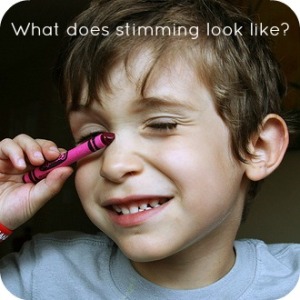One of the best parts of working at an Autistic-friendly organization is that I can take quick minute or two stim breaks when I need them. (Stim/stimming is short for self-stimulation/self-stimulate. I’ll go into much more detail later, but essentially, a stim can be anything from jumping, spinning, rubbing something with a specific texture, saying a specific something, or any number of stereotyped or repetitive behaviors.) There’s a quiet room next to my workspace that’s usually uninhabited, and if I need to, I can go inside and jump, spin and flap my hands to calm down and regulate myself.
At the end of the day, after all the guests at the Aquarium are gone, and we’re closing up operations, if I get overwhelmed, I’m free to small stim (hand flap, fidget, apply pressure to my nasal bridge) in our end-of-operations room. If I need to jump, spin, or slap my hands, I can step into the hallway and do so.

Autistics might stim for three main reasons. First, for self-regulations. In the above examples from work, I might get overwhelmed for any number of reasons–a guest tried to walk off with one of my pens, a guest asked if the price of admission included my stapler and I didn’t get that he was joking until his daughter told me he was, some folks came in wearing bright orange shirts and it burned my eyes–and to deal with the anxiety, stress and potential pain, I need to stim.
Self-regulatory stimming doesn’t just help combat or calm negative emotions or feelings. It can also help us regulate intensely happy or joyful experiences. Last month, I had the amazing privilege of meeting Laverne Cox when she came to Stanford to speak. Not only did I get to speak with her beforehand with a small group of trans students, but afterwards I got to speaks with her with a group of campus activists and organizers. Laverne Cox is a true possibility model for me, and twice during the after talk, I got so overwhelmed with my emotions that I needed to excuse myself and go on the outside balcony of the room and stim.
Another reason Autistics might stim is sensory seeking. Allistics (that is, neurotypical [that is, not Autistic]) also sensory seeking. For example, if you like the taste of a certain dish, you might savor it, or make it again. If you like the texture of a certain fabric, you might buy several blankets made out of that fabric. But Autistics often exhibit higher, more intense versions of sensory seeking than Allistics do. This could be rubbing a piece of wood for an hour, or listing to certain music while rocking back and forth. For me, I love to apply pressure for to my nasal bridge, in particular with fresh, Ticonderoga-Dixon pencil erasers (yes, there is a difference between them and other erasers). In 1st grade, I remember whenever we had to sit in class for a lesson or be still for a while, I would take my pencil’s eraser and press it against my forehead. I wasn’t feeling particularly emotional, or in need of regulation–it just felt fucking good. Still does, and I do it whenever I feel like it. I now also have glasses that I wear that I’ve adjusted so they apply special pressure to my fore brow and bridge.
The final reason why an Autistic might stim is for self-expression. Stimming is the easiest way for me to express myself and my emotions and feelings. I stim differently depending on how I’m feeling. When I’m generally happy, my hands tend to be bouncier, and my motions more crisp when I stim. When I’m generally not happy, my hands tend to be more chaotic, hurried, and jerky.
Stimming can occur with all major external senses. In this excellent video, Amethyst discusses in more detail the three main reasons Autistics stim, as well as seven senses that Autistics might use when stimming: taste, touch, smell, hearing, sight, proprioception, and vestibular. I’d like to briefly mention two more senses that Autistics, myself included, stimulate–thermoception and nociception. Thermoception is how we sense and process heat, or the absence of heat. I’m really heat sensitive, but have difficulty feeling cold. To me, cold things make me feel blissfully numb, and it’s a sensory experience that helps me regulate myself, as well as one that seek out just because it makes me feel good. Nociception is how we sense pain, or the lack of pain, and a sense I often stimulate when I’m extremely stressed or angered. Usually I will intensely dig my fingernails into my skin, or slap my arms extremely hard. At times, I’ll even bite my hands. Allistics often get worried and afraid for me when I engage in this, but my intention isn’t to harm or hurt or kill myself. Rather, the pain that I feel helps me deal with the outside stress.

This leads to the main point of this post. Allistics often misunderstand stimming, and discourage it in a number of formal and informal ways.
For example, as a kid, my family would make me sit on my hands, or make me restrain my body in other ways to stop from stimming. At times, they even told me it made them not want to be around me, and that if I couldn’t stop fidgeting, I wouldn’t have any friends.
In school, I was told not to stim (fidget was their word) because it was considered disruptive. I was never overtly punished, for which I’m truly fortunate–too many Autistics have to suffer “quiet hands” reminders–but it was very clearly not tolerated.
I developed a lot of shame around stimming, something Amethyst also did and talks about in the video, as well as many other Autistics. For years, I hated my innate need to move or engage with the sensory world differently than others.
But last October, well before I had begun to believe I might be Autistics. I told my therapists about how I would in the private of my bedroom or the bathroom fidget or flap or even, if no one was around, jump or spin, and she told me to pursue this as a stress release. It felt terrifying to try it outside of my private areas. I remember flapping in the elevator at work for the first time and having a mini-freak out about whether or not there were security cameras in there, and if the security folks where watching me right now in disbelief.
As I began to realize that I was Autistic, and there was a reason for this, and that others were dealing with similar issues I was, and that stimming was something that many engaged in proudly, it became empowering for me to stim. It felt like a beautiful form of self-acceptance, and a fuck you to the world for trying to get me to stop (I’m a rebel, what can I say?) I’m so much better able to deal with my outside world and environment in large part because I feel much more free to express my feelings and regulate my emotions in the way that is most natural to me.
Allyship Tip: If you consider yourself an Autistic ally, make sure that you and the spaces you occupy are as stim positive or neutral as possible. Don’t stare at us. If you’re curious, ask questions politely, but many of us still have a lot of shame to work through with regards to stimming, and folks staring at us can make us relive that pain and make us abandon stimming, which can be quite hard on us.
❤ Piija Suoynna Riistia
